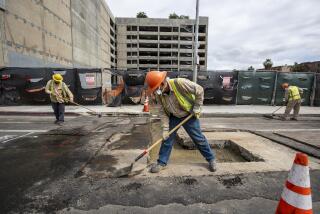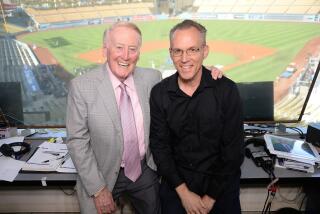Orthopedist Going Strong at 80--No Bones About It
- Share via
The question seemed innocent enough.
“How long have you been retired?”
Dr. J. Vernon Luck’s dislike for the word was immediately visible.
“I have not retired,” the 80-year-old orthopedic physician said during an interview in his Hancock Park home.
“I have changed direction (from clinical practice) to orthopedic research, but I still work a 9- or 10-hour day.”
Case closed. Suffice to say, if the word retired is uttered within earshot of Luck, it had better be used with the proper modifiers.
Matter of Definition
“He’s retired from clinical practice ,” said his son, Dr. James V. Luck Jr., 45, of Glendale, president-elect of Orthopaedic Hospital’s medical staff.
Fifteen years ago, the senior Luck, the former medical director of Orthopaedic Hospital in Los Angeles, could have begun devoting his leisure hours to golf. An Irishman with an engaging grin, a nearly full head of white hair and a penchant for one-liners, Luck could easily rest on his laurels.
Besides serving Orthopaedic Hospital as medical director from 1955 to 1968, Luck has served on the staffs of the Hospital of the Good Samaritan, Childrens Hospital of Los Angeles, Hollywood Presbyterian Medical Center and Los Angeles County/USC Medical Center. Since Luck received his medical degree from the University of Missouri 55 years ago, he has written more than 75 scientific papers and two books, including a definitive orthopedic textbook.
Many Accomplishments
During his 52 years as an orthopedic surgeon, he reimplanted the nearly amputated arm of a man (reportedly the first successful arm reimplantation surgery in the United States) and performed what was believed to be the first elective surgery (total hip replacement) in a patient with hemophilia. In 1941, he invented the Luck Bone Saw and also is credited with improving many other pieces of orthopedic equipment.
Orthopaedic Hospital’s research facility, the J. Vernon Luck MD Orthopaedic Research Center, was named in his honor last April.
He has trained 103 orthopedic residents at Orthopaedic Hospital and says he has no plans to slow down. These days, Luck, also a clinical professor emeritus at USC, is developing a device to repair fractures in patients who have undergone total hip replacement, studying biomechanics and investigating bone tumors in children, among other research topics. Working with his son, he is also revising his 1950 textbook, “Bone and Joint Diseases.”
“He’ll die in the harness,” said his daughter, Diane Luck Carter, 40, of Manhattan Beach.
His many work-related interests leave little time for hobbies, although he claims he may take up golf again.
Exercises Occasionally
“I was 50 before I took up golf,” Luck said, “and I never had much of a game.” Occasionally, Luck works out on a stationary exercise bicycle/rowing machine next to the window in his home office.
J. Vernon Luck, who was born in Hannibal, Mo., sets his own schedule.
“My time’s my own,” he said. Some mornings, he heads for his tiny laboratory in Orthopaedic Hospital’s Lowman Outpatient Center.
Sometimes he works from the suite of offices he still shares with his son in the building next to the hospital. On other days, Luck works from the second-floor office in his home.
Luck’s wife, Ramona, 72, accommodates and understands his devotion to work. A former newspaper reporter and Look magazine editor, Ramona Luck volunteers her writing abilities to the First Congregational Church of Los Angeles, lectures on Christian symbolism and is writing a book on the topic.
Of her husband’s projects, she says, “I help him all I can, plus I take care of all the family investments and run the house.”
No matter how pressing Luck’s research or writing schedule, he makes time for home life, which revolves around church and family.
Family get-togethers, especially visits from the Lucks’ six grandchildren, ages 5 to 15, are frequent.
“Work is as much his recreation and avocation as his vocation,” his son said.
“Some people wait until retirement to do what they want to do,” said his daughter, a journalist. “But this (orthopedics) is what he wants to do. All of his interests revolve around orthopedics, but around many areas of orthopedics. He’s not narrow.”
Interest Sparked Early
Luck said his interest in orthopedics began when he was 4 and his mother’s leg was amputated due to abscess formation in her knee.
His family has become intensely involved at Orthopaedic Hospital. Ramona helped found the Searchlighters, a hospital support group. Diane worked as a volunteer, and Jim completed his residency there before joining the staff.
Luck said he and hospital administrators didn’t always agree when he was medical director. But he developed a reputation for doggedly pursuing what he thought the hospital, the patients and the doctors needed. For several years, he argued that the fifth floor of the Lowman Outpatient Center should be reserved as research space. Today, it is.
Though some might describe Luck as stubborn, he believes tenacious is more accurate.
“Or,” he said, his blue eyes brightening, “how about sagacious? “
Fondly Recalled
Former residents recalled that tenaciousness, along with Luck’s impressive bedside manner and fondness for his students.
“He was the doctor who was always (regarded as) too nice to his staff people,” remembered Chadwick Smith, a Los Angeles orthopedist and former student. “He didn’t follow a dictatorial approach to teaching.”
“He taught compassion for the patient,” said Robert Gustafson, a Pasadena orthopedic surgeon who also trained under Luck.
Luck’s willingness to listen to his students’ opinions was criticized by some colleagues who thought residents should be seen and not heard, but it earned him the admiration of his students. One group of residents presented him with a plaque of appreciation, which now hangs in his research lab. At the bottom is a phrase Luck frequently heard from his colleagues: “You’re too good to those boys.”






